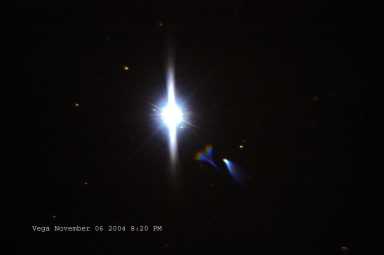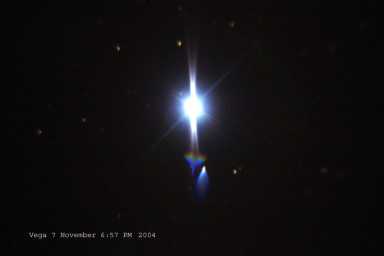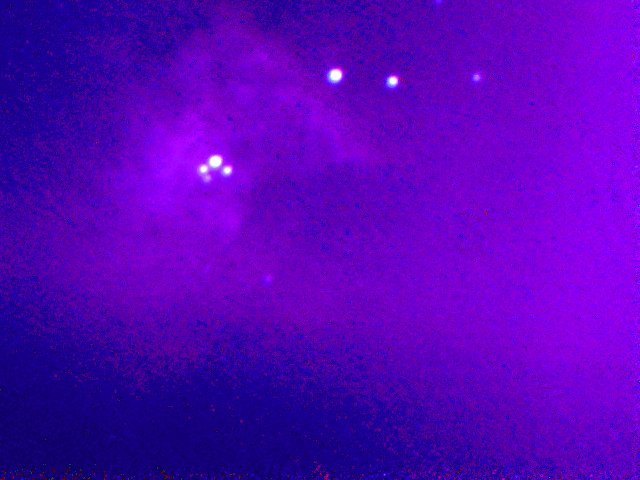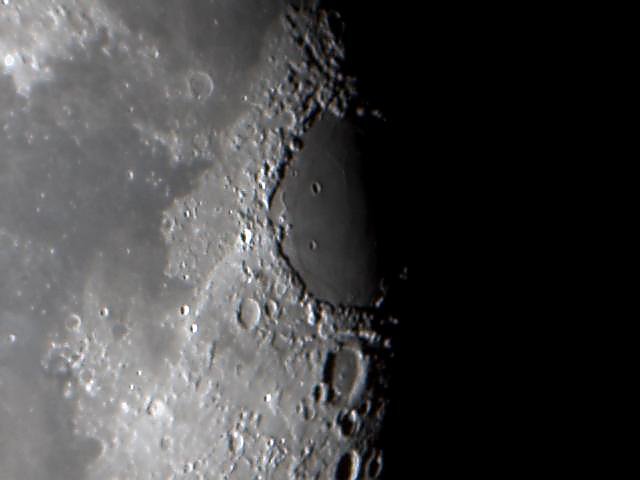Last updated: 23 December 2004
|
Last updated: 23 December 2004 |
This page documents astrophotography comments, tips, and photos. Contributions welcome. Be certain to see the other articles on the main Astrophotography page.
Subject: PST and DSI prominences
Sent: Tuesday, December 21, 2004 17:26:29
From: bderidde@suffolk.lib.ny.us
I just received my PST and my DSI in the mail, i have already tried my
hand unsuccesfully at Astrophotography with a Canon Rebel, and a LX10. I
hooked up the DSI directly into the PST, and for the life of me can't
focus the sun, i just get this grainy bright blur of a sphere. Im using
just the DSI and a laptop and no focal reducer. Do i need a Reducer?, i
tried a 2x barlow with no luck. I still have the Canon Rebel but i want
to use the DSI, for the ease in image processing. Please help, and info
would be greatly appreciated. I can't wait to hook it up to my new 6"
refractor Meade, but that will be another headache for a greenhorn like
me.
Brian
Mike here: I'm still working to get a good focus myself with the PST and Nikon Coolpix. The problem is the wavelength of the light coming through. It is sufficiently different that it is necessary to change the focus from that of "normal" light. I'm hoping to try again later this weekend, weather and schedule cooperating. [update: still no luck]
Subject: camera placement Sent: Monday, December 20, 2004 16:21:59 From: joel devine (joeldevine2003@yahoo.com) i have recently purchased an etx-70at telescope from meade and have a question you will probably be able to resolve for me. will i get a better more magnified.better resolved photo from an eyepiece camera adapter or a standard rear mounted placement? is there a difference other than where its mounted? i plan on mounting a very good nikon 35mm camera to it thanks..Mike here: When you mount a camera at the rear port you essentially have a 350mm telephoto lens. If you want to increase the magnification you will have to use an eyepiece and do "afocal" photography. However, keep in mind that as magnification increases so do the affects of tracking errors and vibration (from the wind, your hand while focusing, or the motors).
Subject: Astrophotography through the eyepiece Sent: Monday, December 20, 2004 04:37:43 From: Dave Staughton (staughton@email.com) I recently bought an ETX-105 and have been enjoying some excellent observing on the rare clear nights here in the southern UK since my purchase! I have been trying some photography through the supplied 26mm eyepiece with my Pentax 555 digital camera. Despite using the maximum 5x optical zoom there is much vignetting and this also restricts the f.o.v. to much less than can be seen with the eye. To reduce the vignetting problem the camera lens needs to be as close as possible to the first lens in the eyepiece but this is not possible as it is recessed about 15mm into the eyepiece tube. I am suprised just how deep down the lens is since even without wearing my glasses I cannot get my eye close enough to see the full f.o.v. this eyepiece offers. Short of cutting off the top 15mm of the eyepiece tube, which is a bit drastic, I cannot think how to solve the problem. I have a few questions: Has anyone taken this drastic action, and how successful was it? Do the 32mm or 40mm series 4000 eyepieces have the same problem with the recessed lens? Is there an alternative (not too expensive) eyepiece in the 26-40mm range that is better suited to this type of photography? Thanks for the great website. It has certainly helped me to get up-to-speed and enjoy what the ETX can offer. DaveMike here: You likely need an eyepiece with longer "eye relief", which gets the focal plane further from the end of the eyepiece. One other thought: try macro mode if the camera has it.
Subject: Help me understand! Sent: Sunday, December 12, 2004 08:05:47 From: jenny.melwin@swipnet.se I have an etx 90 here in sweden, and would like to start taking pictures trough it. Can I use a "off axix guider" ? And what things must I have to start shooting? Im alredy shooting objekts with a piggyback mounted camera, but I want to make a further step. Would be happy for an answer! clear skies // JennyMike here: See the Helpful Information: Astrophotography page for lots of info on astrophotography. There are articles on tips and accessory reviews as well as information on specific cameras and imagers. Yes, you can use an off-axis guider BUT you may not get as precise tracking as you expect. If you have an Autostar-capable ETX-90 then you might want to check out the new Meade Deep Sky Imager (DSI).
Subject: Astrophotography in Scotland. Sent: Wednesday, December 8, 2004 12:53:09 From: Pipex (the_lordys@dsl.pipex.com) I have an ETX105, I've had it only a few months and I have really enjoyed using it, but I am really wanting to try my hand at astrophotography ! I have read the various articles many times about camera adapters and digi-t systems that allow you to connect your digital camera to the scope but what really confuses me is the "software" and how images are "stacked" ? What is the best & easiest software to use and just how do you "stack" images ? I have seen images that people have taken and have been really impressed. Can anybody help?Mike here: Image stacking is automatic with the software that comes with Meade's LPI and DSI imagers. If you want to use images from other sources, check out Registax and Astrostack for Windows or Keith's Imager Stacker for Macs. There is info on using Registax as well as other image processing information on the Helpful Information: Astrophotography page.
Subject: Astrophotos w/ digital slr Sent: Friday, December 3, 2004 05:59:39 From: dan.p.brodt@verizon.com (dan.p.brodt@verizon.com) Your website is very nice. I have a new Canon 20D digital slr and want to start into astrophotography with my 10" LX200. Problem is there a[ppears to be a gigantic void in info on how to connect and usage of the new DSLR's. Would you know of any direction I might take. I have Canon's DSLR info but that is lacking. Thanks! dan@MarylandMike here: Scopetronix.com has adapters for DSLRs.
Subject: CANON T70 ADAPTER RING?
Sent: Saturday, November 13, 2004 08:00:52
From: c pain (fixer1@onetel.net)
Vie just bought a MEADE 64 T adapter.
Could you please help me with a problem, I need to buy a T ring for an
old CANON T 70 with a 35-70mm FD lens with 52mm screw thread.
Does the T ring fit into the front of the lens { which is what I thought }
or does it fit into the BAYONET mount of the camera body?
Thanks in advance Mike
Cyril
Mike here: The T-Ring goes into the bayonet mount. You remove the camera lens and the telescope optics acts like a long telephoto lens.
And:
Thanks Mike your very navigable that's why I asked you.And:
Sorry Mike I meant to say KNOWLEDGEABLE HA! HA! HA! Cyril
Subject: Small Digital Cameras or Webcam for the ETX 125? Sent: Saturday, November 13, 2004 05:11:23 From: Anna316@wmconnect.com (Anna316@wmconnect.com) As a novice with lots of questions and a limited budget, I am back again trying to narrow down my immediate choices beyond film photography. I've had interesting exchanges with folks both on Yahoo groups and from Scopetronix. I have been told by Scopetronix that any digital camera with a small lens attached to their Maxview 40mm will ease vignetting and provide satisfactory results, whereas some folks on the digital page at Yahoo have suggested that a Webcam will do a better job. My question is- not having a laptop to haul around at the moment (leaving the Meade DSI out for now), in your experience, are you just as pleased with digital camera results as webcam? Thanks for being so patient with my questions. A month ago, I had absolutely NO idea about any of this, and it's directly because of your website that i have the confidence to continue asking dumb questions- I HAVE learned so much!! Thanks again, Tom HMike here: Since both a webcam and the LPI or DSI require a computer, if you don't have a computer that you can use at the telescope, then it would appear that your decision is made: you will have to go with a digital camera. As you can see from all the examples on the Helpful Information: Astrophotography page, most digital cameras, including inexpensive ones, will perform nicely on the brighter objects (like the Moon, Venus, Jupiter, and Saturn). Fainter objects are more difficult but can be done as evidenced by the examples on the Site.
Subject: Vega and ? Sent: Friday, November 12, 2004 06:42:00 From: Offwork11@aol.com (Offwork11@aol.com) I took these pictures of Vega on consecutive nights. Six and 7 November of this year. From Virginia Beach, VA. Using a LXD 55 10 inch SN reflector. Camera is a Nikon D100 coupled with a 15 mm eye piece. The first on 6 November at 8:20 PM was a 30 second shot at 400 ISO and the second on 7 at 6:57 PM November was a 2 minute shot at 200 ISO. I have no idea what these other objects are. They appear to have moved from one are around Vega to another. Could you give me any insight to what they might be.Mike here: Those are light flares. They are due to your camera lens most likely. But still nice shots!r/ Shep Kaplan 

And:
Thanks for your time. Yes the look very cool. r/ Shep Kaplan
Subject: digital questions for the ETX125 Sent: Thursday, November 11, 2004 05:09:59 From: Anna316@wmconnect.com (Anna316@wmconnect.com) I mentioned recently that I bought the Scopetronix DSLR Maxview. I haven't used it yet as my ETX is being exchanged. I intend to use the Maxview for film SLR, but now realize (after seeing the great digital shots shown on your website!) that I would like to do digital as well. Here's my question(s): Do all digitals have the capacity for stacking? Is it better to get as much optical zoom as possible in a digital camera? Are there advantages of a digital SLR? I was talking to someone at Scopetronix who mentioned that with an Slr (like the Canon EOS), you can't see the image right away. Sorry to hit you with so many questions, but if I could be better off with attachments other than the Maxview( which is pricey AND heavy!) it would be very helpful to know, so I can make an exchange if necessary. Thanks again foir your help, Tom HanniganMike here: Since stacking is done in software on the computer, images from any digital camera can be stacked. The problem with ANY digital or film camera is that you can't see faint objects in the camera. So alignments and experience are important. Yes, weight can be a problem but can be offset by adding a counterweight system.
Subject: astrophotography on the ETX125 Sent: Thursday, November 4, 2004 20:15:00 From: Anna316@wmconnect.com (Anna316@wmconnect.com) I seem to remember somewhere on your site you're mentioning that you can do prime focus or eyepiece projection photography from the top eyepiece holder. That would be wonderful if it were true ,and to know the accessories required. It seems one cannot expect to photo from the back once an object rises more than say, 50 degrees above the horizon. I found it pretty frustrating trying to photograph the recent eclipse overhead as the shaft of the 64T Adapter banged on the base. Are we stuck with only afocal alternatives? I am usung a Minolta SRT101. Thanks, Tom HMike here: Are you referring to the Meade Basic Camera Adapter discussed on the Accessory Reviews: Astrophotography page?
And:
Yes. I remember now the thing about the Meade Basic Adapter was the length (shortness) of the piece, but that it did fit on the top. I have since ordered the Maxview variable eyepiece adapter from Scopetronix. That should fit into the top (right?) and allow me to use a variety of lenses as well as be able to use it for digital SLR when I can afford one of those Canon EOS models. Tom Hannigan
Subject: LPI Image Processing Sent: Tuesday, November 2, 2004 06:24:12 From: Jim.Beston@questintl.com (Jim.Beston@questintl.com) I attach a raw and a couple of processed images of M42 taken with an LPI using my 10" LX200GPS. The problem is that I havn't much of a clue as to how to do image processing and, after reading the Meade LPI IP Manual I now have less of a clue! The emergence of the M42 nebula (at least in part) from the raw image was acheived purely by chance manipulations in Paint Shop Pro! Is there a "Dummies Guide" to Image processing available that anyone could reccomend? If I remenber correctly the raw image was 10 x 16 sec exposures combined on a hazy night with an almost full moon - I was very supprised to get what I did out of it!! I'd like to learn a bit more before my DSI arrives!!Mike here: Trying deep sky photography during a Full Moon is a rather difficult thing to do. The bright sky will tend to wash out the details and perhaps even make it impossible to capture any usable data. As to dummies guide, you might check out "Photoshop for Astrophotographers"; reviewed on the Accessory Reviews: Books page. Also, there are several excellent guides on astrophotography on the Helpful Information: Astrophotography page.Thanks a lot Jim

Subject: a question about image accesories Sent: Saturday, October 30, 2004 23:20:52 From: Stan Drery (johngen_j@yahoo.com) john from greece. Whats the difference between the imager ( eg. the lpi and dsi) , the digital camera and the ccd stuff?Mike here: Well, there are LOTS of differences. But basically it comes down to price vs features vs capabilities vs technologies. That's the short answer. Without getting into the specs of each item (which are available from the appropriate sources), which works best for you will depend upon your expectations, requirements, and budget.
Subject: Limited Field of View for Photographing Whole Moon - ETX105 Sent: Thursday, October 7, 2004 14:10:47 From: Kevin Smith (kevin.e.smith@btconnect.com) I am new ameteur astronomer in Kent, UK and I've found your site extermely useful. I recently upgraded my Meade 114mm Newtonian for an ETX105 and whilst I am delighted with it, I am no longer able to fit the whole moon into the field of view for eyepiece projection photography, using the 26mm super plossl that comes with it. I am using the BC&F 'ULTRA' camaera adaptor to fix my digital camera onto the eyepiece. Do you know what eyepiece I would need to purchase in order to achieve this ? I thought perhaps a 40mm or is there anything like a reverse barlow ? I have one other question you may be able to help with - has anyone managed to get the Meade Autostar controller working via a USB virtual comm port ? Any tips on getting this configured gratefully received eg. does the telescope need to be switched on and aligned or can I test the PC-control function in daylight ? At the moment I get an error message from Autostar to say that it can't communicate with the telescope. Regards, Kevin LPI image attached - second night using it. Really enjoyable.Mike here: You can use a Focal Reducer or Wide Field Adapter; see the Accessory Reviews: Showcase Products page. As to USB, see the "PCs and USB" on the Helpful Information: Autostar Info page. And yes, you can set up in daylight indoors to play with the system. Thanks for the nice photo.
Return to the top of this page.
Go to the July-September 2004 Astrophotography - Tips page.
Go to the April-June 2004 Astrophotography - Tips page.
Go to the January-March 2004 Astrophotography - Tips page.
Go to the 2003 Astrophotography - Tips page.
Go back to the Astrophotography Page.
Go back to my ETX Home Page.